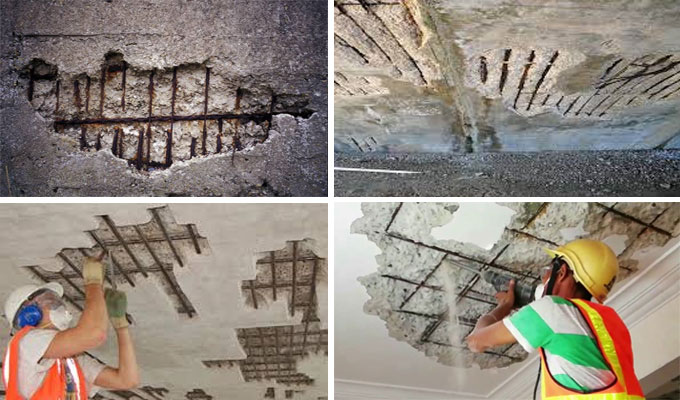
Concrete Spalling - Causes and Repair
Spalling of Concrete: A phenomenon where specific parts of concrete breaks and detaches itself from the structure, exposing the reinforcement of its inside to the environment.
Cause of this break away includes the certain chemical reaction inside the concrete leading to the formation of high volume foreign products. Lack of space inside the concrete allows the new products to increase the pressure inside, which results in formation of cracks for the release of the pressure outside.
These products causing problem are formed due to the following factors:
1. Corrosion
2. Alkali aggregate reaction
3. Chemical attack
4. Sulphate attack
5. Pollution
Impacts of Concrete Spalling
- People might get injured as well as objects might get damaged by the concrete debris, which riskens people?s life.
- Due to the exposure of the reinforcement of the concrete, chances of corrosion increases, leading to the collapse of the entire structure.
- It also reduces the load carrying capacity of the structure.
- Concrete spall may also decrease the value of the building by affecting the aesthetic look of it.
- Proper treatment is required to prevent the spread of corrosion, which increases the maintenance cost associated.
Causes and Prevention
| Causes | Prevention |
| Inadequate Cover will increase the vulnerability of the crack in the atmosphere resulting in corrosion. | Proper supervision and structural design along with cautious handling of material. |
| Freeze Thaw Cycle: In cold regions, the water seeped will turn into ice being greater in volume than that of water. | Creating artificial air pockets inside the concrete with the help of air-entraining agent can manage the increased volume. |
| Alkali in cement reacts with silica in presence of water to form Alkali Silica Gel(ASG) which again is higher in volume. | The reaction can be debilitated by reducing the alkali content in cement or by using silica free synthetic aggregates. |
| Explosive spalling may occur due to exposure in higher temperatures such as during fire. | Increasing the fire safety of the building reduces the chances of explosive spalling. |
| Improper Compaction initiates corrosion, thereby spalling. | This problem can be rectified by proper supervision and use of vibrators for proper compaction. |
| Low water content leads to reduced workability making it hard for compaction, resulting in crack formation. | Correct mix design ratio and proper supervision needs to be followed to avoid mishaps during mixing. |
| Sulphate present in the atmosphere and Chloride (occurs to the surface present in the atmosphere) on reaction with the concrete results in spalling. | Using sulphate resistant cement and coating the surfaces with anti-rusting paints might prevent spalling. |
| A structure with rough finished surface tends to hold more water increasing the seepage which further encourages spalling. | Providing smooth finishes. |
| Environmental Pollution causes chemical attack on the concrete resulting in spalling. | Applying water repellent paints on the surface prevents spalling. |
Repairing Spalling Concrete
- The concrete at the spalled areas needs to be removed to expose the corroded steel bars.
- The exposed steel bars need to be scraped and cleaned.
- Usage of a wire brush to remove the rust.
- Two coats of anti-rust paint should be applied to the steel bars.
- Before patching the area, applying a bonding agent to the affected surface ensures proper adhesion.
- Patching up the hacked area using polymer modified cement mortar.
F-A-Qs
1. What is the meaning of concrete spalling?
ANS. Spalling is the surface failure that occurs when a material such as concrete, brick, or limestone is subjected to excess moisture, corrosion, weathering, and much more.
2. Is concrete spalling dangerous?
ANS. Concrete spalling is more common in colder climates. Because spalling can be a sign of deep, dangerous damage that can result in further issues, it's important to repair spalling at the first sign of brokenness or flaking.
3. What causes Spalling?
ANS. There are many reasons such as Sulphate attack, Chloride attack, Rough Finishes, Improper Water content, Polluted environment, Inadequate cover to reinforcement, Freeze thaw Cycle.
4. What does spalling look like?
ANS. They may look like round or oval depressions along the joints and surfaces.
5. How to prevent concrete spalling?
ANS. a. Maintaining adequate cover to reinforcement.
b. Using vibrators for proper compactions.
c. Using silica free aggregates.
d. Adopting fix design ratio of concrete,
e. Using sulphate resisting cement in concrete.
6. How to fix spalling?
ANS. Using anti-rusting paint on corroded steel, water repellent paint on the surface and proper smooth finishing.
7. What is the lifespan of concrete?
ANS. 30-100 years.
8. What is the best Concrete resurfacer?
ANS. QUIKRETE? Concrete Resurfacer provides an economical alternative to removing and replacing existing old, concrete spalls.


